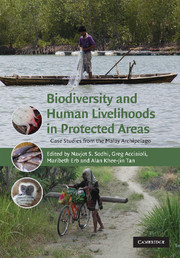Book contents
- Frontmatter
- Contents
- List of contributors
- Acknowledgements
- 1 General introduction
- Part I Conservation needs and priorities
- Part II Conservation with and against people(s)
- Part III Legal and governance frameworks for conservation
- 23 Introduction to Part III
- 24 Protected-area management in Indonesia and Malaysia: the challenge of divided competences between centre and periphery
- 25 Protecting sovereignty versus protecting parks: Malaysia's federal system and incentives against the creation of a truly national park system
- 26 What protects the protected areas? Decentralization in Indonesia, the challenges facing its terrestrial and marine national parks and the rise of regional protected areas
- 27 Learning from King Canute: policy approaches to biodiversity conservation, lessons from the Leuser Ecosystem
- 28 Conclusion to Part III
- 29 General conclusion
- Index
- References
25 - Protecting sovereignty versus protecting parks: Malaysia's federal system and incentives against the creation of a truly national park system
from Part III - Legal and governance frameworks for conservation
Published online by Cambridge University Press: 12 November 2009
- Frontmatter
- Contents
- List of contributors
- Acknowledgements
- 1 General introduction
- Part I Conservation needs and priorities
- Part II Conservation with and against people(s)
- Part III Legal and governance frameworks for conservation
- 23 Introduction to Part III
- 24 Protected-area management in Indonesia and Malaysia: the challenge of divided competences between centre and periphery
- 25 Protecting sovereignty versus protecting parks: Malaysia's federal system and incentives against the creation of a truly national park system
- 26 What protects the protected areas? Decentralization in Indonesia, the challenges facing its terrestrial and marine national parks and the rise of regional protected areas
- 27 Learning from King Canute: policy approaches to biodiversity conservation, lessons from the Leuser Ecosystem
- 28 Conclusion to Part III
- 29 General conclusion
- Index
- References
Summary
Introduction
The language of protected areas in Malaysia is a confusing one; the nature of Malaysia's federation and the historical development of state-centred control over land and forest resources have ensured that protected-area planning would, for the most part, be a localized and uncoordinated affair from the very beginning of the nation's founding.
The Malay sultanates that were the precursors of modern Malaysian states evolved along rivers and were very mobile in response to threats from invaders. This is a reflection of the Malay world's amalgam of groups that have migrated and invaded throughout the archipelago. These various migrations and invasions shaped the face of the sultanates. Power, influence and control were never tied to specific areas, but were rather founded upon relationships, beliefs and practices. Therefore a sultan's power survived temporary dislocations and could be relocated further up the river if need be. It is no coincidence that the major rivers of the Malay Peninsula share their names with the various sultanates.
As the British expanded their control over what would become Malaysia, the sultanates enjoyed a certain degree of security, although their sovereignty was gradually eroded. Royal courts settled down in the cities where the colonial authorities set up local administrative centres. This contributed to state identity and eventually spatially demarcated and bounded states developed.
The sultans and the states found this arrangement agreeable, and it persisted after independence, with a strong delineation between state and federal powers being enshrined in the Constitution.
- Type
- Chapter
- Information
- Biodiversity and Human Livelihoods in Protected AreasCase Studies from the Malay Archipelago, pp. 384 - 404Publisher: Cambridge University PressPrint publication year: 2007



